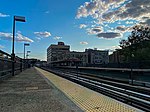Muscota Marsh

Muscota Marsh is a one-acre public park in the Inwood section of the borough of Manhattan in New York City, on the shore of Spuyten Duyvil Creek, a section of the Harlem River. It is adjacent to the much larger Inwood Hill Park and Columbia University's Baker Athletics Complex. The park is notable for its views and for its ecological conservation features."Muscota" comes from a Lenape word meaning "place of rushes" or "place in the reeds". Muscota Marsh is unusual for having both a freshwater marsh and a salt marsh in such a tiny area. Besides attracting plant and animal life, these wetlands are intended to help filter rainwater runoff and thereby improve the water quality of the river. Other facilities include a dock for kayaks and canoes, benches, and walking paths. A wooden deck overlooking the river provides views of Inwood Hill Park, the Henry Hudson Bridge, and the New Jersey Palisades.Opened to the public in January 2014, the park was constructed by Columbia University as part of a deal to construct the new Campbell Sports Center within its adjacent athletics complex. It was designed by James Corner Field Operations, which also worked on Manhattan's High Line. It is cooperatively administered by the New York City Department of Parks and Recreation and Columbia, with the university providing maintenance and security.
Excerpt from the Wikipedia article Muscota Marsh (License: CC BY-SA 3.0, Authors, Images).Muscota Marsh
West 218th Street, New York Manhattan
Geographical coordinates (GPS) Address Phone number Website Nearby Places Show on map
Geographical coordinates (GPS)
| Latitude | Longitude |
|---|---|
| N 40.873294 ° | E -73.918376 ° |
Address
The Inwood Farm
West 218th Street 600
10034 New York, Manhattan
New York, United States
Open on Google Maps









